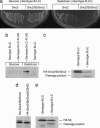A yeast assay probes the interaction between botulinum neurotoxin serotype B and its SNARE substrate
- PMID: 16636286
- PMCID: PMC1447522
- DOI: 10.1073/pnas.0510816103
A yeast assay probes the interaction between botulinum neurotoxin serotype B and its SNARE substrate
Abstract
The seven functionally distinct serotypes (A-G) of botulinum neurotoxin (BoNT) are dichains consisting of light chain (LC) with zinc-dependent endoprotease activity connected by one disulfide bond to heavy chain with neuronal-cell translocation and receptor-binding domains. LC-mediated proteolysis of soluble N-ethylmaleimide-sensitive factor attachment protein receptor (SNARE) proteins and consequent inhibition of synaptic vesicle fusion to the presynaptic membrane of human motor neurons are responsible for flaccid paralysis associated with botulism. LC endoproteolysis is complex, requiring highly extended SNARE sequences at the surface of intracellular membranes and prompting our development of a genetically amenable assay to monitor the interaction between BoNT/LC and its SNARE substrate. Using BoNT serotype B as a model, the assay employs a chimeric SNARE protein where a portion of neuronal synaptobrevin (Sb) is fused to Snc2p, a Sb ortholog required for protein secretion from yeast cells. Regulated expression of serotype B-LC in yeast leads to cleavage of the chimera and a conditional growth defect. To assess utility of this assay for monitoring SNARE protein cleavage, we growth-selected chimeric SNARE mutations that inhibited proteolysis. When these mutations were introduced into Sb and examined for cleavage, substrate residues located near and distal to the cleavage site were important, including residues positioned near the Sb transmembrane domain, an unexplored aspect of BoNT cell intoxication. Additional mutations were positioned in a nine-residue SNARE motif, supporting a previously assigned role for this motif in LC recognition and providing proof of principle for the application of yeast-based technology to study intracellular BoNT/LC endoproteases.
Conflict of interest statement
Conflict of interest statement: No conflicts declared.
Figures





Similar articles
-
Structure of botulinum neurotoxin type D light chain at 1.65 A resolution: repercussions for VAMP-2 substrate specificity.Biochemistry. 2006 Mar 14;45(10):3255-62. doi: 10.1021/bi052518r. Biochemistry. 2006. PMID: 16519520
-
Production of an expression system for a synaptobrevin fragment to monitor cleavage by botulinum neurotoxin B.J Protein Chem. 1998 Jul;17(5):453-62. doi: 10.1023/a:1022570518330. J Protein Chem. 1998. PMID: 9717740
-
Light Chain Diversity among the Botulinum Neurotoxins.Toxins (Basel). 2018 Jul 2;10(7):268. doi: 10.3390/toxins10070268. Toxins (Basel). 2018. PMID: 30004421 Free PMC article. Review.
-
Monoclonal Antibodies that Inhibit the Proteolytic Activity of Botulinum Neurotoxin Serotype/B.Toxins (Basel). 2015 Aug 26;7(9):3405-23. doi: 10.3390/toxins7093405. Toxins (Basel). 2015. PMID: 26343720 Free PMC article.
-
[Clostridium botulinum and botulinum neurotoxin].Brain Nerve. 2011 Jul;63(7):755-61. Brain Nerve. 2011. PMID: 21747146 Review. Japanese.
Cited by
-
Roles of Asp179 and Glu270 in ADP-Ribosylation of Actin by Clostridium perfringens Iota Toxin.PLoS One. 2015 Dec 29;10(12):e0145708. doi: 10.1371/journal.pone.0145708. eCollection 2015. PLoS One. 2015. PMID: 26713879 Free PMC article.
-
Catalytic properties of botulinum neurotoxin subtypes A3 and A4.Biochemistry. 2009 Mar 24;48(11):2522-8. doi: 10.1021/bi801686b. Biochemistry. 2009. PMID: 19256469 Free PMC article.
-
The blockade of the neurotransmitter release apparatus by botulinum neurotoxins.Cell Mol Life Sci. 2014 Mar;71(5):793-811. doi: 10.1007/s00018-013-1380-7. Epub 2013 Jun 11. Cell Mol Life Sci. 2014. PMID: 23749048 Free PMC article. Review.
-
Towards new uses of botulinum toxin as a novel therapeutic tool.Toxins (Basel). 2011 Jan;3(1):63-81. doi: 10.3390/toxins3010063. Epub 2011 Jan 12. Toxins (Basel). 2011. PMID: 22069690 Free PMC article. Review.
-
Clostridial neurotoxins: mechanism of SNARE cleavage and outlook on potential substrate specificity reengineering.Toxins (Basel). 2010 Apr;2(4):665-82. doi: 10.3390/toxins2040665. Epub 2010 Apr 13. Toxins (Basel). 2010. PMID: 22069605 Free PMC article. Review.
References
-
- Montecucco C., Molgo J. Curr. Opin. Pharmacol. 2005;5:274–279. - PubMed
-
- Montecucco C., Schiavo G. Q. Rev. Biophys. 1995;28:423–472. - PubMed
-
- Shone C. C., Quinn C. P., Wait R., Hallis B., Fooks S. G., Hambleton P. Eur. J. Biochem. 1993;217:965–971. - PubMed
-
- Vaidyanathan V. V., Yoshino K., Jahnz M., Dorries C., Bade S., Nauenburg S., Niemann H., Binz T. J. Neurochem. 1999;72:327–337. - PubMed
-
- Schmidt J. J., Stafford R. G. Biochemistry. 2005;44:4067–4073. - PubMed
Publication types
MeSH terms
Substances
Grants and funding
LinkOut - more resources
Full Text Sources
Other Literature Sources
Molecular Biology Databases

